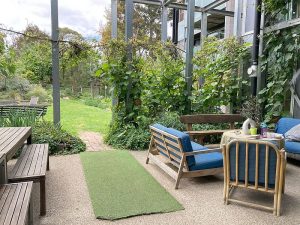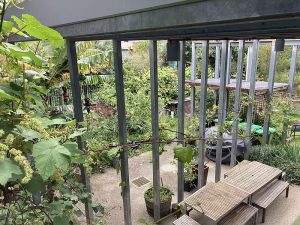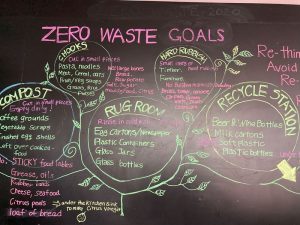The garden at Murundaka Co-housing Community
In November 2023, Ann Stanley visited Murundaka Co-housing Community and interviewed two of its residents, Collette Couper and Sarah Swierzy.
 The Murundaka Cohousing Community is an all-rental, values-based, intentional community in Heidelberg Heights.
The Murundaka Cohousing Community is an all-rental, values-based, intentional community in Heidelberg Heights.
The co-operative was established in 2011. There is a block of 18 custom-built apartments, with 2 free standing houses in neighbouring streets.
Residents at Murundaka are members of Earth Common Equity Rental Cooperative and the Common Equity Housing program. Both organisations are part of the co-housing movement in Victoria and nationally through the Sustainable Living Foundation (SLF).
These initiatives are addressing some of the problems of environmental sustainability, the  shortage of housing and unaffordable rents.
shortage of housing and unaffordable rents.
Residents, Collette Couper and Sarah Swierzy, were guests on a recent episode of the Local Food Connections radio show. Collette lives in one of the two-bedroom apartments with her 5-year-old son, and Sarah lives with her partner in one of the free-standing houses. Sarah showed me around when I visited Murundaka.
One of the features that makes this housing complex exceptional, a showcase of what is possible with creative thinking and political will (it was made possible in part by a grant from the Federal Government in 2008, as part of the stimulus package), is the huge, rambling garden.
 This begins at the back door of the Common House, a large, custom-built space with two big sinks, plenty of bench space, tables, a wood burning heater, and cosy zones built around couches, bookshelves, art and a kids’ play area.
This begins at the back door of the Common House, a large, custom-built space with two big sinks, plenty of bench space, tables, a wood burning heater, and cosy zones built around couches, bookshelves, art and a kids’ play area.
On the adjoining patio there is a comfortable seating area. A banana tree with a hand of still-green fruit enjoys the warmth of a north-facing wall of the apartment building where most of the residents live. There is a firepit.
Deeper into the garden is a large mulberry tree which the residents had recently spent an afternoon shaking to gather the fruit on a huge  tarpaulin, but the tree was still laden, and the ground strewn with large juicy mulberries. Collette told me that mulberries had been, for a couple of weeks, a feature of the desserts at the common meal that takes place every Friday in the Common House.
tarpaulin, but the tree was still laden, and the ground strewn with large juicy mulberries. Collette told me that mulberries had been, for a couple of weeks, a feature of the desserts at the common meal that takes place every Friday in the Common House.
The garden is well-planned and cared-for. The soil has been fed by the large composting system and worm farm and mature fruit trees now yield avocados, cherries, pears, cherry guava, apples, citrus fruits, apricots, other stone fruits, kiwifruit, grapes and feijoas.
There are individual veggie plots, in various states of cropping, with the last of the winter veggies going to seed and new seedlings ready for the warmth of summer. There is also a communal veggie plot.
 At the end of the garden, there is a large chicken pen, empty of residents pending fox-proof renovation. The adjacent forage area is wild with borage and other volunteer plants, including edible weeds and herbs that have thrived on neglect.
At the end of the garden, there is a large chicken pen, empty of residents pending fox-proof renovation. The adjacent forage area is wild with borage and other volunteer plants, including edible weeds and herbs that have thrived on neglect.
There is a gardening committee that takes responsibility for the garden, organising gardening bees on the days of the monthly whole group meeting. Some of the residents are horticulturists and permaculture enthusiasts.
Apart from attending meetings and volunteering on committees such as the gardening and finance committees, residents make a  financial contribution to food for common meals and other expenses such as the proposed new wood heater.
financial contribution to food for common meals and other expenses such as the proposed new wood heater.
Murundaka is a local Wurundjeri word meaning ‘a place to stay or live.’ If living in a community means commitment to shared responsibility, sustainability and growing fresh food, the Murundaka co-housing community is an inspiring model of what could be the future of housing in Melbourne and in cities all over the world.
